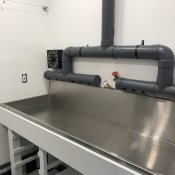Vaughn
Subscriber
I am using my bathroom -- I open the light-proof (at night) curtain and run a fan to the outside while the neg washes in the kitchen.Where do you vent to? do you simply open a door to let the air go to a different room?
if that is the case then I believe that this would be my best option since I will be using the same chemical setup as you
As long as you do not mind the smell, using a fan just to clear the closet out will work for now. I'd run whatever house fans you have and/or open some windows, too. Running a darkroom for a couple decades or so, I hardly can smell regular-strength fixer anymore.













